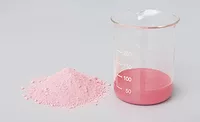ISP Introduces Formaldehyde-Free Biocide for Europe
In Hall 7, ISP has launched
Nuosept® BIC, a high-performance, formaldehyde-free in-can
preservative offered as a drop-in replacement to formaldehyde-containing
preservatives previously used in Europe for protection against microorganisms.
In Hall 7, ISP has launched Nuosept® BIC, a high-performance, formaldehyde-free in-can preservative offered as a drop-in replacement to formaldehyde-containing preservatives previously used in Europe for protection against microorganisms. The water-based, zero-VOC preservative contains three active substances (BIT, IPBC and CMIT/MIT) that work synergistically to preserve products against a broad variety of microorganisms. Engineered with quick-kill activity, ISP will market Nuosept BIC as a universal biocide for wet-state preservation, with the added benefit of plant hygiene. The new biocide formulation has been made commercially available in Europe for formulators of paints, coatings, adhesives, ready-mix building materials and construction chemicals that seek to market Ecolabel-compliant products without compromising the quality of wet-state preservation.
Nuosept BIC is non corrosive and may be used in interior wall paints without risk of “ghost odor.” The water-based dispersion with broad-spectrum activity requires a lower dose than legacy preservatives. With a viscosity of 2000 cps and typically used at dosage levels of 0.1-0.25%, it is highly efficient at killing bacteria, yeast and molds. As demonstrated in acrylic wall paint, Nuosept BIC outperformed classical preservatives based on BIT + MIT in offering a broader activity spectrum against microorganisms as well as better quick-kill efficacy and a lower cost-to-treat ratio.
ISP is also introducing Fungitrol® 940 CR fungicide for dry-film protection of coatings. The new offering is designed to deliver a minimum amount of fungicide to the coating interface over an extended period of time. Based on the controlled release of IPBC (active) through microencapsulation into an inorganic carrier, Fungitrol 940CR may be used to resolve tradeoffs in dry-film protection strategies and to enhance the overall performance of fungicide in use.
According to Karen Winkowski, Sr. Director of Performance Chemicals and Biocides Applications, with the launch of Fungitrol 940CR, paint makers will have better options to maintain coatings free of microbial defacement without relying on high biocide loading levels. “Traditionally, high levels of biocide are added to formulations to ensure a sufficient amount of biocide migrates to the coating surface interface, where they exert their biocidal effect,” she said. “Yet this strategy also renders the biocide susceptible to water leaching under humid conditions and to typical environmental degradation processes, such as UV and heat. We found that by controlling the release of IPBC through encapsulation technology, a minimum concentration is always present at the surface interface.”
In Hall 7, ISP has launched Nuosept® BIC, a high-performance, formaldehyde-free in-can preservative offered as a drop-in replacement to formaldehyde-containing preservatives previously used in Europe for protection against microorganisms. The water-based, zero-VOC preservative contains three active substances (BIT, IPBC and CMIT/MIT) that work synergistically to preserve products against a broad variety of microorganisms. Engineered with quick-kill activity, ISP will market Nuosept BIC as a universal biocide for wet-state preservation, with the added benefit of plant hygiene. The new biocide formulation has been made commercially available in Europe for formulators of paints, coatings, adhesives, ready-mix building materials and construction chemicals that seek to market Ecolabel-compliant products without compromising the quality of wet-state preservation.
Nuosept BIC is non corrosive and may be used in interior wall paints without risk of “ghost odor.” The water-based dispersion with broad-spectrum activity requires a lower dose than legacy preservatives. With a viscosity of 2000 cps and typically used at dosage levels of 0.1-0.25%, it is highly efficient at killing bacteria, yeast and molds. As demonstrated in acrylic wall paint, Nuosept BIC outperformed classical preservatives based on BIT + MIT in offering a broader activity spectrum against microorganisms as well as better quick-kill efficacy and a lower cost-to-treat ratio.
ISP is also introducing Fungitrol® 940 CR fungicide for dry-film protection of coatings. The new offering is designed to deliver a minimum amount of fungicide to the coating interface over an extended period of time. Based on the controlled release of IPBC (active) through microencapsulation into an inorganic carrier, Fungitrol 940CR may be used to resolve tradeoffs in dry-film protection strategies and to enhance the overall performance of fungicide in use.
According to Karen Winkowski, Sr. Director of Performance Chemicals and Biocides Applications, with the launch of Fungitrol 940CR, paint makers will have better options to maintain coatings free of microbial defacement without relying on high biocide loading levels. “Traditionally, high levels of biocide are added to formulations to ensure a sufficient amount of biocide migrates to the coating surface interface, where they exert their biocidal effect,” she said. “Yet this strategy also renders the biocide susceptible to water leaching under humid conditions and to typical environmental degradation processes, such as UV and heat. We found that by controlling the release of IPBC through encapsulation technology, a minimum concentration is always present at the surface interface.”
Looking for a reprint of this article?
From high-res PDFs to custom plaques, order your copy today!






